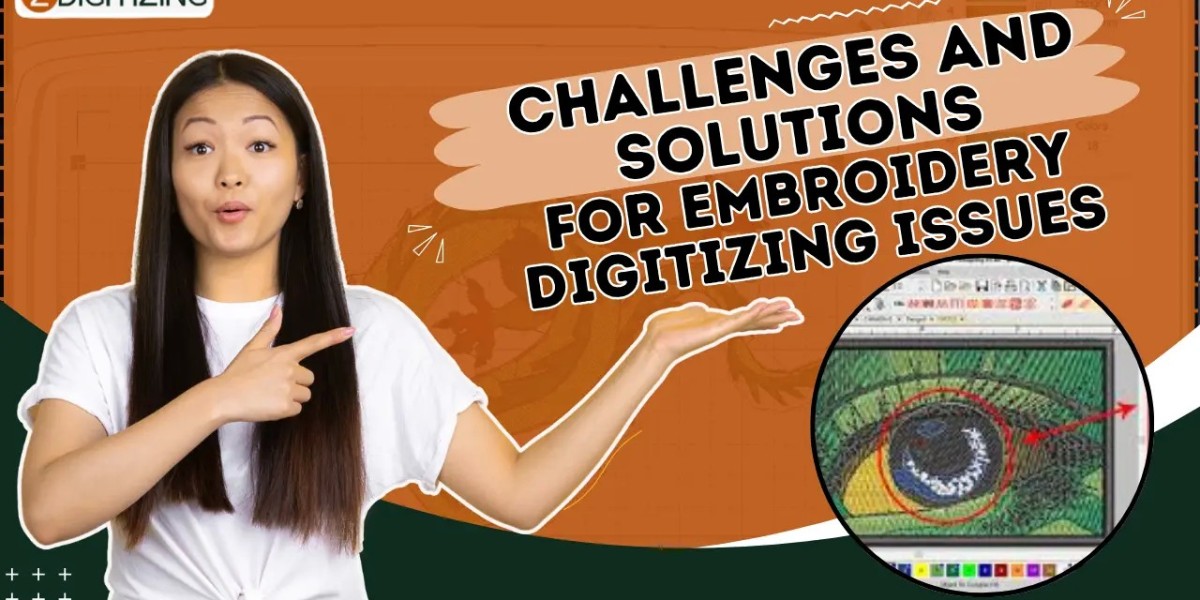Embroidery digitizing is a captivating blend of artistry and technology, transforming intricate designs into stitch-perfect masterpieces. However, this intricate process comes with its set of challenges, testing the skills and patience of even the most seasoned digitizers. In this comprehensive guide, we delve into the common challenges faced during embroidery digitizing and provide practical solutions to ensure your digital designs translate seamlessly into embroidered reality.
The Art and Science of Embroidery Digitizing
Embroidery digitizing is the process of converting digital artwork into a format that an embroidery machine can interpret and execute. This intricate craft involves translating colors, stitch types, and densities to create a blueprint for the embroidery machine's needle. Despite advancements in digitizing software, challenges can arise, requiring a nuanced understanding and a strategic approach to overcome.
Common Challenges in Embroidery Digitizing
1. Complex Designs and Small Details:
Embroidery machines have limitations when it comes to replicating intricate details, especially in smaller designs. Fine lines, tiny text, or delicate features can be challenging to translate accurately.
2. Color Matching:
Achieving accurate color matching between the digital design and the embroidered result can be tricky. Factors like thread type, lighting conditions, and fabric color influence the perception of colors in the final product.
3. Density Issues:
Inconsistent stitch density can lead to uneven embroidery, affecting the overall appearance and feel of the design. Overly dense areas may cause puckering, while insufficient density results in a lack of coverage.
4. Underlay Challenges:
Inadequate underlay – the foundational stitches that support the design – can lead to registration issues, especially in complex or large designs. Insufficient underlay may cause misalignment and distort the final result.
5. Lettering and Fonts:
Small fonts and intricate lettering pose a significant challenge in digitizing. Ensuring legibility, clarity, and proportional spacing require careful consideration to prevent text from becoming illegible or distorted.
6. Fabric Variations:
Different fabrics react differently to embroidery digitizing. The same design may appear differently on a dense, woven fabric compared to a lightweight, knit material. Navigating these variations is crucial for consistent results.
7. Understanding Machine Limitations:
Each embroidery machine has its specifications and limitations. Ignoring or miscalculating these can result in designs that exceed the machine's capabilities, leading to subpar outcomes.
Solutions for Overcoming Digitizing Challenges
1. Simplify Complex Designs:
For intricate or small details, simplification is often the key. Streamline complex elements, eliminate unnecessary details, and focus on preserving the essence of the design. This ensures that the embroidery machine can interpret and replicate the design accurately.
2. Color Calibration and Testing:
Invest time in color calibration and testing to ensure accurate color reproduction. Test the design on sample fabrics with the actual thread to identify and adjust for any color variations before final embroidery.
3. Optimize Stitch Density:
Pay meticulous attention to stitch density. Use a balanced approach, adjusting density based on design elements and fabric type. Experiment with different settings to find the optimal balance that achieves full coverage without causing distortions.
4. Enhance Underlay Techniques:
Implement effective underlay techniques to provide a strong foundation for the design. Experiment with different underlay styles – zigzag, contour, or center walk – to address specific challenges posed by the design structure.
5. Font and Lettering Considerations:
Choose fonts specifically designed for embroidery and consider the size and spacing carefully. Enlarge small text, adjust spacing, and simplify intricate lettering to ensure legibility and clarity in the final embroidered result.
6. Test on Various Fabrics:
Test your digitized design on a range of fabrics to understand how different materials interact with the embroidery. This allows you to make adjustments and fine-tune the digitized file for optimal results on various substrates.
7. Machine-Specific Digitizing:
Tailor your digitizing approach to the specific embroidery machine in use. Familiarize yourself with the machine's capabilities, limitations, and recommended settings to ensure compatibility with your digitized designs.
Advanced Techniques for Precision Digitizing
Beyond addressing common challenges, mastering advanced digitizing techniques elevates the quality of your embroidery designs:
1. Layering for Depth:
Experiment with layering techniques to add dimension to your designs. By strategically layering stitches, you can create texture and depth, enhancing the visual appeal of your embroidered creations.
2. Intricate Pathing for Seamless Transitions:
Refine your digitizing skills to create intricate pathing for seamless transitions between different elements in your design. Smooth transitions contribute to a polished and professional finish.
3. Incorporate Specialty Stitches:
Explore the use of specialty stitches, such as motif fills, to add interest and complexity to your designs. These stitches can enhance specific areas, creating a unique and eye-catching result.
4. Fine-Tune Stitch Angles:
Pay attention to stitch angles in your digitized designs. Adjusting the angle of stitches can significantly impact the visual appearance and texture of the final embroidery.
5. Dynamic Lettering Techniques:
Master dynamic lettering techniques that go beyond basic fonts. Experiment with lettering styles that incorporate curves, flourishes, and unique shapes to create visually striking text in your embroidery.
Troubleshooting Common Digitizing Issues
Even with the most careful digitizing, issues may arise during embroidery. Here are solutions to common digitizing problems:
1. Thread Breaks:
Adjust tension settings, use high-quality thread, and ensure proper maintenance of your embroidery machine to minimize thread breaks during embroidery.
2. Puckering:
Address puckering by adjusting stitch density, using appropriate stabilizers, and ensuring proper tension. Experiment with different underlay techniques to provide better support.
3. Misalignment:
Misalignment can result from inadequate underlay or uneven fabric tension. Double-check your underlay and stabilize the fabric properly to prevent misalignment issues.
4. Uneven Coverage:
Inconsistent coverage may occur due to variations in stitch density. Fine-tune your digitized design to achieve uniform coverage across the entire embroidery.
5. Distorted Lettering:
If lettering appears distorted, revisit your digitized file and adjust the spacing and size of the text. Test on scrap fabric to ensure clarity and legibility.
Conclusion: Mastering the Digital Tapestry
Embroidery digitizing is a dynamic process that demands a combination of artistic vision and technical finesse. By understanding common challenges and implementing strategic solutions, you can navigate the complexities of digitizing with confidence. Whether you're a novice or an experienced digitizer, the journey to mastering the digital tapestry is an ongoing exploration of creativity and precision.
As you embark on your digitizing endeavors, remember that each challenge presents an opportunity to refine your skills and elevate the quality of your embroidered creations. Embrace experimentation, stay informed about technological advancements, and celebrate the artistry that transforms digital designs into tangible, stitched masterpieces.
Zdigitizing
ZDigitizing is offering a wide range of digitizing solutions to meet the needs of vector artwork services businesses and individuals alike. With expertise in logo digitizing, 3D puff digitizing, cap digitizing, and applique digitizing, zdigitizing ensures high-quality and precise embroidery designs.
Their team of skilled embroidery digitizer is well-versed in converting images to embroidery digitizing, making it easy to transform your logos, artwork, or designs into stitch files. Whether you have a PNG or JPG image, ZDigitizing can seamlessly convert it into embroidery-ready files, ensuring accurate reproduction of intricate details and vibrant colors.
ZDigitizing prides itself on delivering quick turnaround times without compromising on quality. They employ state-of-the-art software and machinery to create flawless embroidery designs that bring your vision to life. Their commitment to customer satisfaction, attention to detail, and competitive pricing sets them apart in the embroidery digitizing industry.








